QUALITY CYCLING CLOTHING SINCE 1996 - THE UK'S FIRST RETRO MANUFACTURER
QUALITY CYCLING CLOTHING SINCE 1996 - THE UK'S FIRST RETRO MANUFACTURER
RETRO APPAREL
COLLECTIONS
Cycling Clothing
ACCESSORIES
Mapei Cycling Team 1993 - 1997
October 16, 2019 10 min read

Johan Museeuw taking the win at the 1996 Paris - Roubaix monument ahead of teammates Gianluca Bortolami & Andrea Tafi to complete an all-MAPEI podium. Photo: John Pierce, Photosport International.
Mapei was an Italian professional cycling team that was active in the peloton from 1993 to 2002. Famous for its striking, multi-coloured team kit that featured the colourful cubes of its products, the Mapei cycling team dominated the sport for a decade winning an incredible 653 races along the way.
In part one, we recount the early years of the team where from humble beginnings, it morphed to the most powerful team in the peloton. Part two will be published in early November 2019.
1993 - The start of the MAPEI team
The Mapei cycling team started from a very humble beginning thanks to an all too common occurrence in the lower echelons of professional cycling - when a team runs out of money mid-way through the season.
The Eldor - Viner team had started the 1993 season at the Trofeo Laigueglia, a traditional Italian season opener, with Greg Lemond (GAN) on the start line and Lance Armstrong (Motorola) the eventual winner in front of the team's own Stefano Della Santa. In the first monument of the season, Luca Gelfi added to the team's success finishing second behind the stylish Maurizio Fondriest at the 84th Milano San Remo.
Despite the fantastic start to the season, the wheels were already starting to fall off before the Giro d'Italia, with the team surviving on Viner's sponsorship money as the Eldor agreement turned out to be a work of fiction.
Step forward Giorgio Squinzi, head of the international Mapei company, who was passionate about cycling, who, with his friend Oriello Pederzoli's advice still in his ears, bought the team outright days before the Giro d'Italia.
Taking design cues from Mapei's product packaging, Tuscan company Parentini produced the first-ever Mapei jersey just in time for the Grande Partenza in Porto Azzuro, with the first iteration using a lighter background behind the cubes. Towards the end of the season, Parentini refreshed the design, using a darker blue background that would be present on virtually all subsequent Mapei team jerseys.
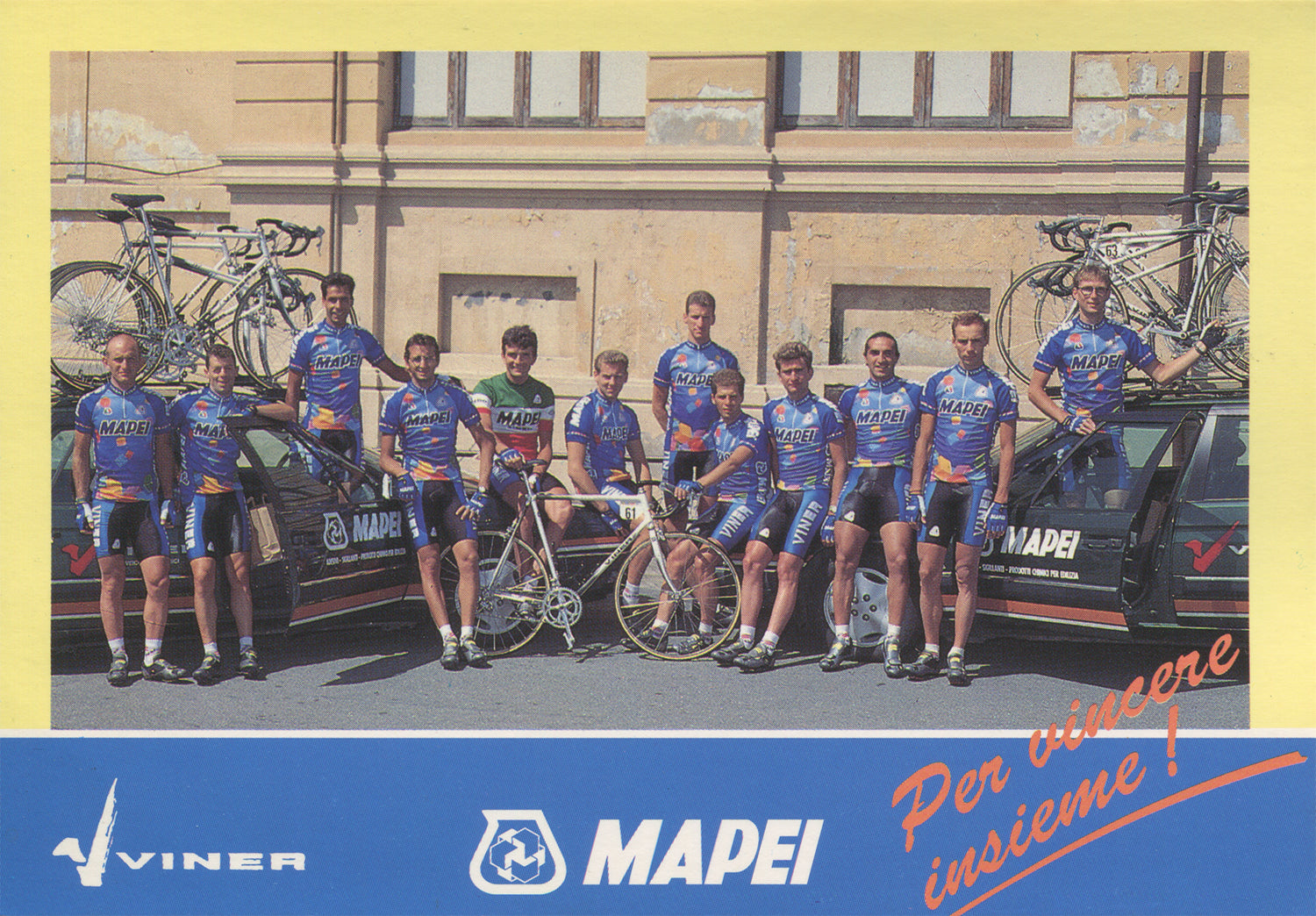
The MAPEI cycling team taken on 25th May in 1993.
Whilst many naturally think of Andrea Tafi as the first Italian champion in MAPEI kit (Prendas Ciclismo was at one point the only place you could buy a replica version of Tafi's kit), it was Marco Giovannetti who wore the very first Maglia Tricolore with the MAPEI logos on the chest, side panels and shoulder.
Giovannetti won the Italian National Road Championship in the Summer of 1992, which meant him earning the right to wear one of the most famous of all jerseys in the peloton.
Giovannetti was the rider-manager of the fledgeling team, and was certainly not ready to hang up his wheels. Despite being in the twilight of his career, he won a stage at the Giro d'Italia and finished fourth overall in his home tour, as well as having placed the same in the first Grand Tour of the season, the Vuelta a España. Giovannetti, however, lacked further results and left the team at the end of the season.
The kudos for Mapei's first-ever win goes to Stefano Della Santa, who won the Trofeo Melinda, an Italian single day race, on 24th July, taking the win from Mauro Gianetti and Wladimir Belli with his arms aloft as he passed the finish line.
It was Della Santa's second victory of the season, having taken the victory at the Giro di Campania in March, but this was the start of things to come for what was one of the most successful Italian professional cycling teams of all-time.
1994 - Mapei Clas, the start of a super team
The closure of the Spanish CLAS - Cajastur team towards the end of 1993 saw both teams merge into one giving 30 riders a chance to shine the following season.
After a team predominately filled with Italian riders, the merger with CLAS brought six different nationalities together which suited the international customer base of Mapei. The fusion between the two came about by Ernesto Colango, who subsequently supplied the Mapei team bikes until the very end. Such brand loyalty to a bike supplier is certainly a rare thing in today's professional peloton, although there are parallels with Team INEOS and their bike supplier Pinerello.
The Mapei team was a truly international affair. Fernando Escartín and Abraham Olano led a strong Spanish contingent, while Franco Ballerini and Gianluca Bortolami were at the forefront of an internal squadra azzura. Switzerland's Tony Rominger was the team's leader for the Grand Tours.
Rominger duly delivered by donning Mapei colours, if only briefly, for his third consecutive victory at the Vuelta a España. The Swiss led the race from start to finish, pulling on the maillot oro at the end of stage one to the delight of Dott. Squinzi.
In 1994, the Tour de France visited the UK for the first time since 1974. As well as the race action itself, we got pretty excited to see GB MG's Flavio Vanzella stuck in the same post-race traffic jam in the car right next to us - even the wearer of the Maillot Jaune couldn't avoid the traffic chaos between Brighton and Portsmouth.
Once the race was back on French soil, Bortolami won stage 6, but some sublime end-of-season form saw him take wins also at the Leeds Classic, the Zurich GP, second place at Paris-Tours giving him the overall victory in the World Cup which certainly made up for his torrid time at Paris-Roubaix that saw him puncture five times as well as swearing at Squinzi's wife in frustration.
1994 also saw Sportful supply the team's cycling kit for the season, a relationship that would last right up until the penultimate season. I personally owned a Mapei Clas jersey, purchased from Geoffrey Butler Cycles, which happened to be the first full-zip jersey I owned.
After the Giro di Lombardia, the season, however, was not over.
On the 22nd October, Tony Rominger bested Miguel Indurain's Hour Record, covering 53.832km in a virtually empty velodrome. Weeks later, Rominger went again on 5th November, this time on a visibly more aerodynamic white Colnago bike fitted with some wonderful FIR lenticular disc wheels, setting a new benchmark of 55.291km at the Velodrome du Lac, Bordeaux.
Thankfully for Eurosport viewers, Stephen Roche was David Duffield's co-commentator offering valuable insight making the Hour Record bearable.
1995 - Mapei GB with Patrick Lefevere
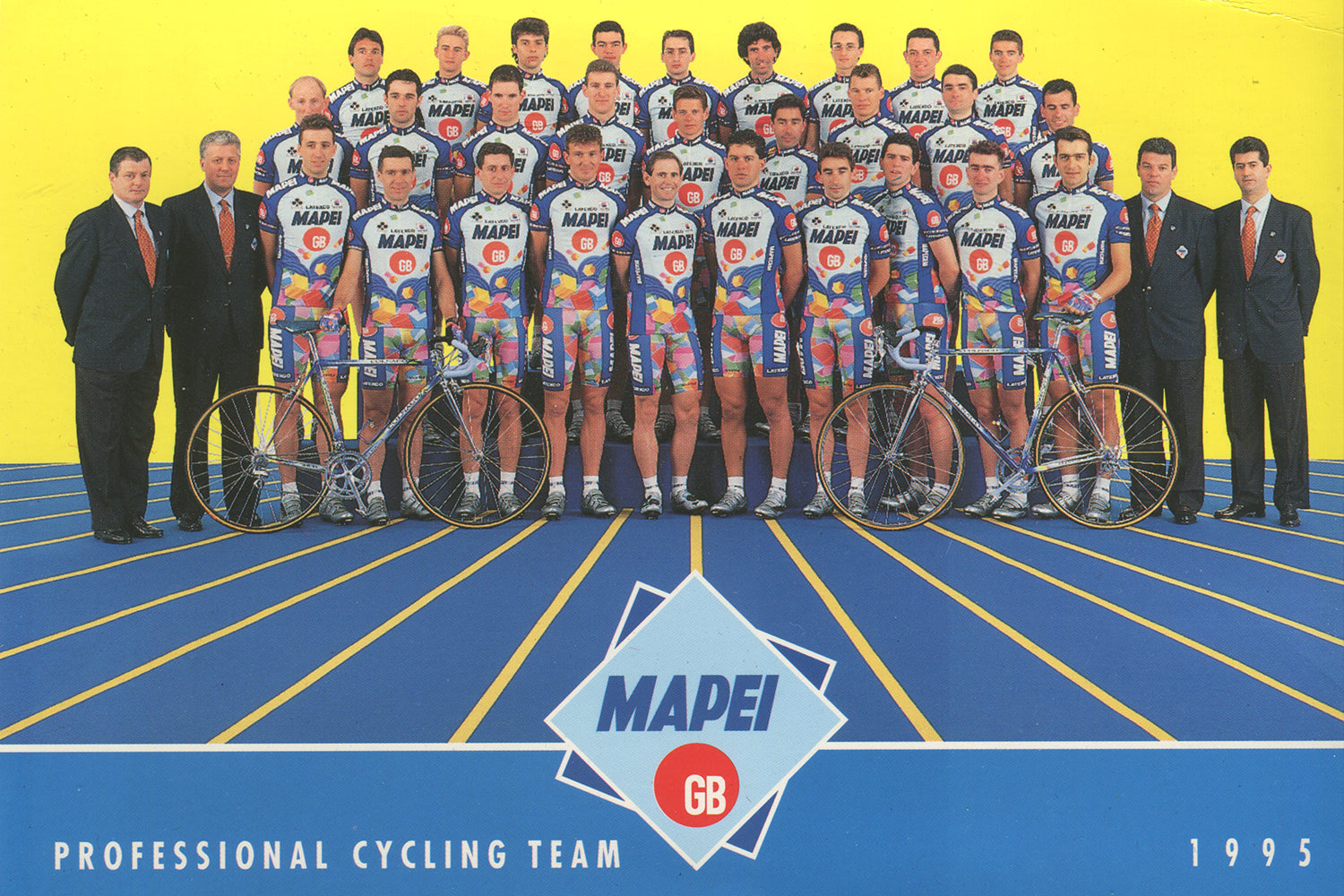
The MAPEI-GB cycling team postcard from the 1995 season with sponsors Mapei, GB, Latexco, Shimano, Colnago, Sportful, Briko and Enervit.
Riders come and go, and with some stellar talent added to the roster thanks to the amalgamation of the Belgian GB-MG team, one could argue that the most important signing for the 1995 season was, in fact, the team's new DS Patrick Lefevere.
Now Dott. Squinzi had a team that could take on all-comers, with riders like Johan Museeuw, Franco Ballerini and, in an unusual mid-season transfer, the prodigy Frank Vandenbroucke from Lotto.
The team hit the ground running, with Museeuw taking the Trofeo Laigueglia in February, whilst Ballerini won Belgian's prestigious Omloop Het Volk, setting up some serious inter-team rivalry for the up and coming Monuments.
Mapei's approach was beginning to change the way teams operated during the season. With such a strong line up of proven winners, team leaders like Museeuw could race less often and focus on prestigious races that were more important to fans and sponsors alike.
I had been a sprinter and only a sprinter at Lotto. I knew I could do other things, but in Lotto we raced 150 times a year and we were expected to win as often as possible. The best way I could do that was being a sprinter. I knew I could do other things, but I never got the chance.
When I went to GB-MG, there was less pressure and I could prepare for bigger races. It was the same at Mapei, only more so, because there were even more good riders. To win a Classic you have to focus on it, train specifically and use other races to prepare for it.
You can only do that in a big team, especially where there are other riders who can win races too.
Johan Museeuw. Cycle Sport, May 1997.
Pre-race favourite Museeuw took his second victory at Tour of Flanders in the Mapei jersey, winning solo thanks to the herculean efforts of both himself and his team.
Despite suffering an early-race puncture, Museeuw attacked on the Berendries climb to join Fabio Baldato ( MG Maglificio - Technogym) where the leading pair worked together, until Museeuw dropped the pony-tailed Italian on the steeper sloops of the Muur van Geraardsbergen.
After the terrible conditions the previous year, Paris-Roubaix was dry and dusty with blue skies that saw Ballerini attack with 30km to go, launching a memorable solo assault aboard his Shimano-equipped Colnago C40.
With Ballerini riding across the cobbles with his face masked by his Briko Shot sunglasses, his victory sealed a great Northern Classics season with team-mate Museeuw in the world cup lead thanks to his third place on the day.

Taking revenge after 1994, where he missed out on the RVV title to Gianni Bugno (Polti) by a mere 7mm, Johan Museeuw took his second Tour of Flanders win in 1995. Photo: John Pierce, Photosport International.
Rominger took on the 1995 Giro D'Italia with a formidable team, and after claiming the Maglia Rosa on the second stage, the Mapei team rode at the head of the peloton to guide their leader to a Grand Tour victory.
Whilst the strength of team riders like Andrea Chiurato, Daniele Nardello, Andrea Noe and Andrea Tafi, it was plain to see that the Mapei team also benefitted from the internal rivalry of Gewiss Ballan's Berzin and Ugrumov who although wore the same jersey, were not riding together at all.
The Mapei team ended the season atop the UCI team standings, had won the World Cup thanks to Museeuw, had won the Giro D'Italia with Rominger, had the current road World Champion in Olano after his victory at altitude at Duitama, Colombia and had earnt 81 victories in total.
1996 - Mapei domination at Paris Roubaix
Patrick Lefevere must have needed buckets full of diplomacy for one of Mapei's finest moments when they left the field in their wake entering Roubaix's outdoor velodrome with three Mapei teammates - Johan Museeuw, Gianluca Bortolami & Andrea Tafi ready to battle for victory.
But they didn't sprint it out, the riders rolled over the line, in the order that later turned out had been determined by Dott. Squinzi who called Lefevere whilst watching the race unfold on the TV in Italy.
It was a memorable, visually stunning moment, expertly captured by many including John Pierce illustrating this article, and Mapei used the three riders in newspaper and magazine adverts captioned È cosa nostra (It's our business).
Whilst Museeuw and Bortolami were happy with the situation, Tafi was clearly not, and it was through him that the information got outside of the team. Lefevere was left to resolve the fallout.
Patrick Lefevere. Cycle Sport, November 2006.It was a reward to Johan from Squinzi that he was allowed to win. In 1993 and 1995, Johan had played the loyal team-mate to Ballerini, staying behind and watching the opposition while Ballerini finished second in '93 and then won in '95. Andrea Tafi was angry about it, but then he won Paris-Roubaix in an equally beautiful way in 1999.
Museeuw further added to his palmarès with numerous podiums before the seasons' end by winning the world road race championships in Lugano, Switzerland, destroying the hopes of Swiss rider Mauro Gianetti as well as taking advantage of a headless Italian team.
Tafi finished the end of the season with impressive wins at the Paris - Bruxelles and Giro di Lombardia, the later got him a special place in Dott. Squizini's heart.
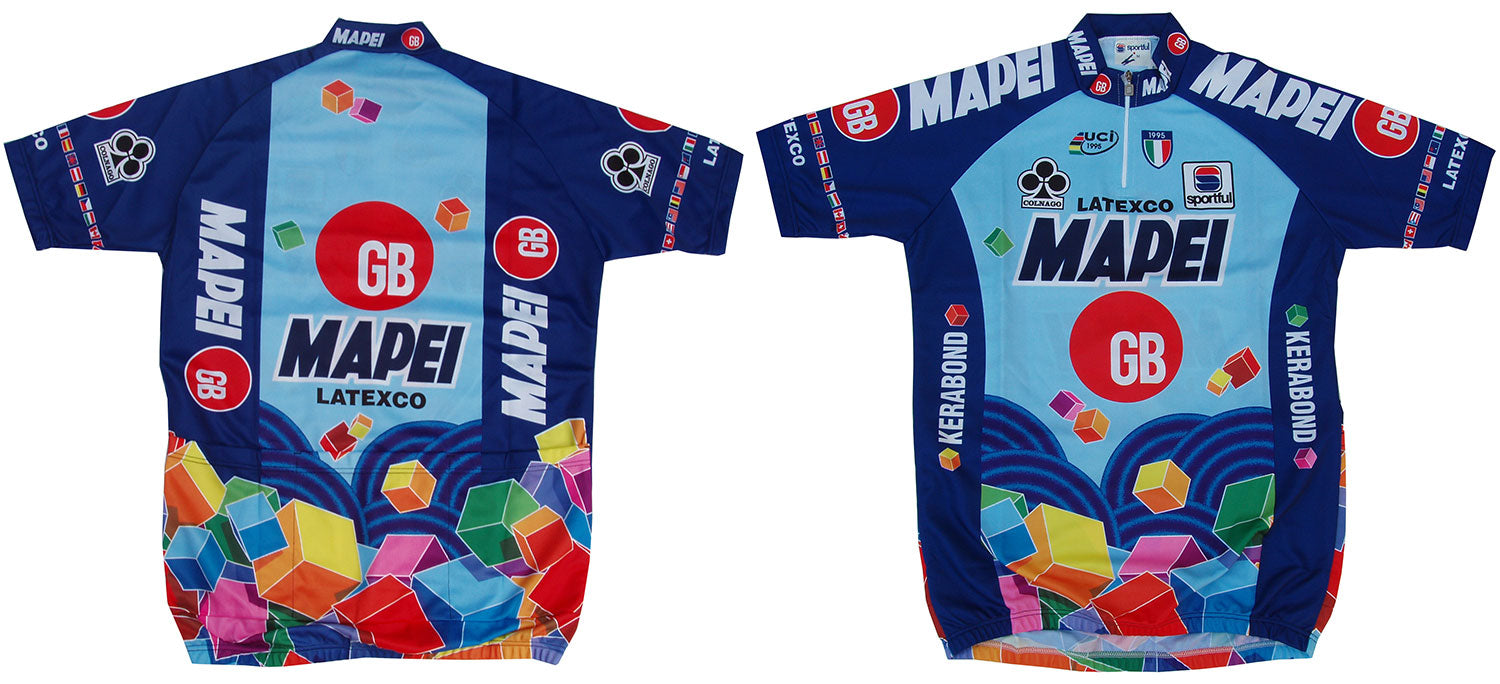
The Mapei GB Colnago 1996 team jersey produced by Sportful.
As well as Tafi, a new generation of Mapei pros were graduating with success with the media-friendly Frank Vandenbroucke starting to repay the team with wins at Trofeo Laigueglia, Scheldeprijs and the notoriously tough GP Ouest France Plouay.
Despite his obvious success, it's fair to say that the Mapei Tifosi didn't really take Rominger to their heart compared to the classics specialists such as Ballerini, Tafi, Museeuw and Bortolami.
Rominger left the team at the end of the season after his manager Marc Biver negotiated a big contract with Cofidis which didn't really pan out for either rider or team.
Whilst the Mapei team recorded 82 victories for the season, Rominger wasn't the only rider to go at the end of 1996, with the Spanish arm of the Mapei cycling team let go after their relative lack of success compared to the Belgian-Italian professionals.
Exit Abraham Olano and Manolo Beltran to Banesto.
1997 - Quantity over quality
The lead signing for the '97 season was undoubtedly Gianni Bugno. The enigmatic Italian star was considering joining the team in '93, but his contract with Gianluigi Stanga and his Polti team prevented it.
But Dott. Squinzi eventually got his man, although what should have been a beautiful and productive relationship failed to bring the necessary results. Bungo contributed only a one victory to the team's haul of 95 victories with a stage victory at Le Tour de Langkawi (where Tafi won two) and a stage at the Vuelta a España the following season.
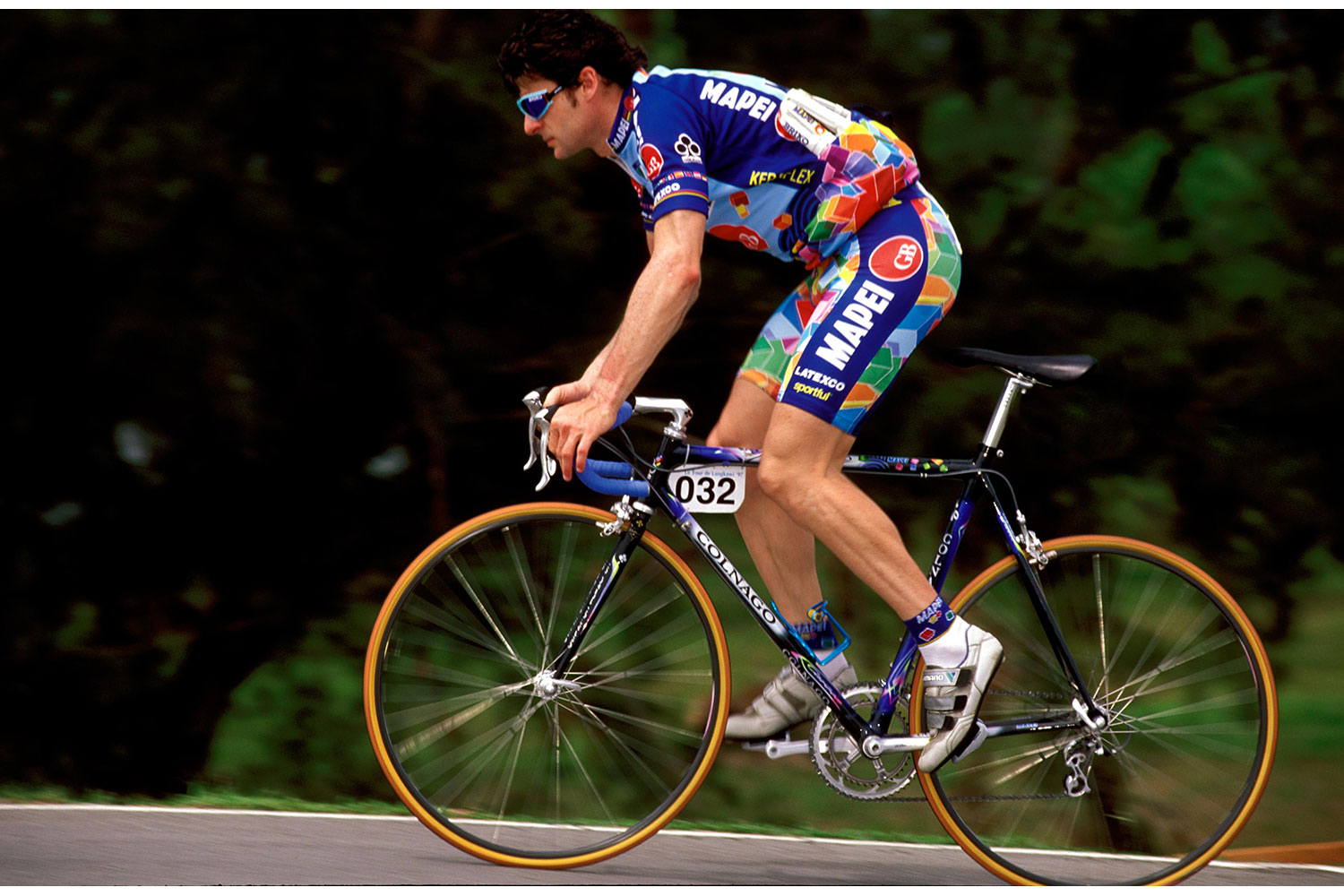
Gianni Bugno in action at the Tour de Langkawi. Mapei was often present at the race with Gabriele Missaglia (1998) and Paolo Lanfranchi (1999/2001) winning the multi-stage event in Malaysia. Photo: John Pierce, Photosport International.
World road race champion Johan Museeuw started with three stage wins at the Ruta del Sol, which was unexpected given Belgium was hit by some of the worst weather for 50 years, plus he had to undergo minor knee surgery after a training crash in December left him with an inflamed right knee.
Despite the inevitable Curse of the Rainbow Jersey comments in the press, the team saw this as a sure sign that he was on course for another series of storming rides in the up and coming classics.
Winner of last season's final Monument, the Tour of Lombardy, Andrea Tafi made no secret of the fact that he had been training hard all winter in preparation for Milano San Remo.
But during this sweet and sour period, the Mapei cycling team came away from the Classics empty-handed, whilst Zabel, Sørensen, Guesdon, Bartoli and Riis won with Tafi bagging the UK's Wincanton Classic and the classically Italian Coppa Sabatini.
Mapei is a great team. Almost everybody wants to ride for us but not many are given the chance.
Andrea Tafi, Cycle Sport, February 2000.
For any other professional cycling team, this series of results would have been cause for a huge end-of-season celebration. Newcomer Pavel Tonkov finished a close second to Gotti at the Giro whilst taking three stages before completing his season with stage victories at the Vuelta.
With Frank Vandenbroucke continuing with his gradual progression in one-week races, the team's sprinters duly delivered on wins per kilometre with Tom Steels, Ján Svorada and even lead-out man Stefano Zanini taking 10, 13 and 3 wins respectively.
Tour sprints are a big fight but Stefano Zanini guided me well. It was like being behind a big tractor. You could eat a sandwich one kilometre before the finish and then it was up to me to have the legs.
Tom Steels. Rouleur, 19.5.
Although 1997 would be something of a transition year, the team started to amass a mighty fine collection of national champions. After the various championships, the team had the coveted Italian (Gianni Faresin), Belgian (Tom Steels), Japanese (Yoshiyuki Abe) and Swiss (Oscar Camenzind) jerseys in addition to Museeuw's rainbow jersey.
This was critical for Prendas, as we were well known for providing fans with all sorts of special edition team kit, with both the Italian and Belgian replica jerseys made by Sportful extremely popular with Mapei supporters around the globe.
We also sold a royal blue team tracksuit that featured both Mapei and Sportful on the chest, as well as a hint of those glorious colourful cubes.

Tom Steels Belgian Champion jersey with Mapei GB Colnago logos produced by Sportful.
To be published in November, part two of our series will follow the final five years of the team from 1998 - 2002, where Mapei dominated single-day races, but failed to replicate that success in the overall standings in the Grand Tours.
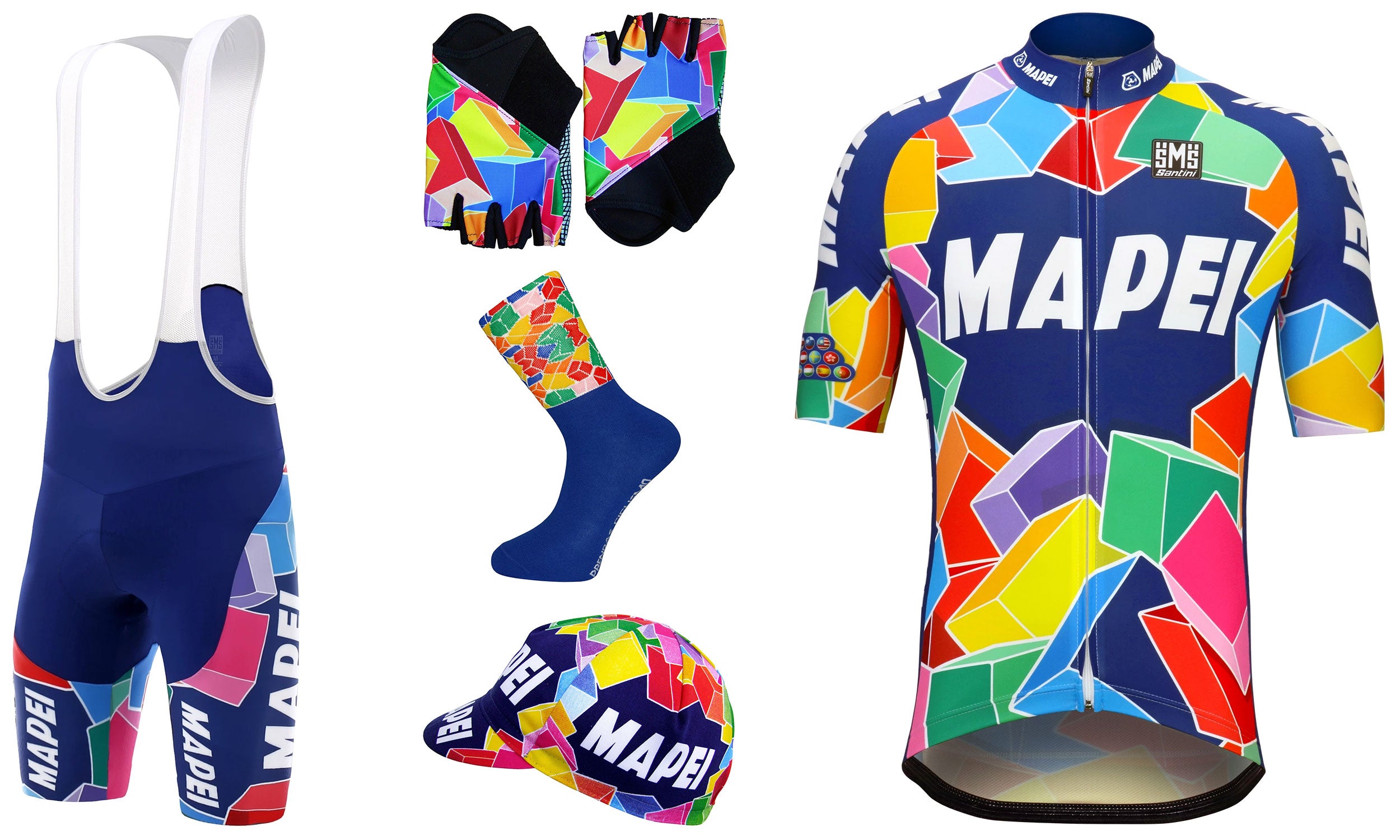
You can buy MAPEI cycling jerseys & team kit at Prendas Ciclismo.
Also in News and articles from Prendas Ciclismo

Prendas' Best-Selling Caps of 2024
January 21, 2025 4 min read
With 2024 in the books, we're looking back at your favourite caps of the year. From cult classic movies to the jungle with a whole lot of Italian flair, check out our best-sellers and grab a new cap!

Vas-y Barry! Hoban wins Ghent-Wevelgem for Gan Mercier Hutchinson
May 15, 2024 8 min read
In an extract from his autobiography, Vas-y Barry, the only British winner of Ghent-Wevelgem, Barry Hoban tells how he won the cobbled classic in 1974, beating Eddy Merckx and the cream of Belgian cycling.

Our Best Selling Caps of 2023
January 15, 2024 4 min read
We know caps here at Prendas Ciclismo, and we know that you love all the styles we have on offer. So every year, we look back at our best-selling cycling caps for the previous year for you to discover a few new styles. Is your favourite cycling cap featured on our list? Read on and see!
Subscribe
Sign up to get the latest on sales, new releases and more …

